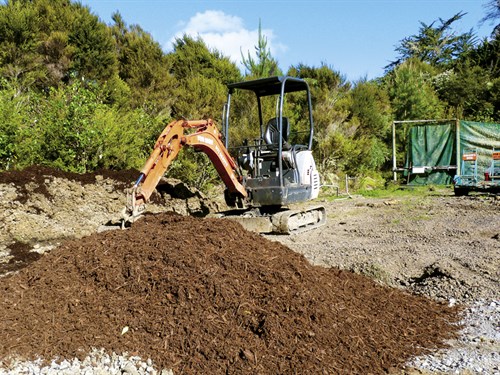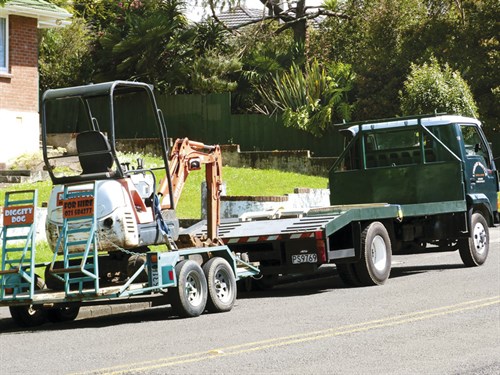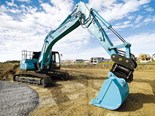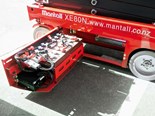Kubota KX41-3 review











|

|

|

|

|
Deals on Wheels puts the 1.8-tonne Kubota KX41-3V from DiggityDog to test
Having decided I needed to make a hardstand to park my growing collection of restored trucks on, I spent a couple of days pondering how I was going to dig out an area of clay, about 15 by12 metres in area.
One option was to call in a local contractor, allowing me to go about my normal business while the work got done.
This option seemed like sound use of my time at first, but nowhere near as much fun as hiring a digger and doing the job myself. Besides, it had been several months since I'd sat at the controls of anything with tracks and I needed to keep my hand in.
I was well aware that by doing the job myself I'd be doing someone else out of work. But on the other side, I'd be putting money in the pocket of the firm I'd be hiring the digger from.
So, having salved my conscience on the morality front, I figured the next step in the process would be to make a decision as to which company I would give my business to. When I was testing a scissor lift, I recalled seeing a 1.8 tonne Kubota machine for hire from DiggityDog Hire.
It turns out DiggityDog is a bespoke business, with only a five-tonne ZX50U Hitachi and the 1.8 tonne Kubota KX41-3 in its fleet. The owner, Jamie, quoted $250 plus GST per day, which sounded good enough to me.
When I turned up at DiggityDog's Penrose depot to collect the machine, I did think for a moment of unloading it from its tandem trailer and putting it up on the deck. However, considering the logistics of releasing the tie-downs and relocating the rock bucket and spade, I figured it'd be best to simply hook the trailer onto the truck and head off to start work as quickly as possible. When I unloaded the little Kubota at the worksite, I looked at the size of the task and found myself wishing that I'd hired the five-tonne machine. But I then realised my truck could only legally carry a 3.5–4-tonne digger anyway.

One immediate advantage of using the smaller machine was getting some much-needed time on the machine, honing my operating skills.
As I don't operate diggers on a daily basis, I knew the first half hour or so at the controls wouldn't be all that productive, so I began by removing a thin top layer of scoria.
It had been exceptionally wet over the previous few weeks, which could have made the going tough, as I had to dig down in some pretty sticky clay to 300mm in places, although this was tempered by a better-quality base where 150mm would suffice.
I did, however, get a bit of exercise during the day from climbing on and off the machine to spade the clay from the bucket.
It was clear the Kubota KX41-3 had had a fair bit of use in its life, but it handled the job at hand with ease. I found I only ever needed to run the engine at between half and three-quarter revs, except when I needed extra speed to get it from one part of the property to another.
With a reach of about three metres fully extended, I found I could easily make a cut, then slew the machine around 180 degrees and dump the clay in a pile.
Then all I had to do when I had enough of a stockpile, was to reposition the machine and repeat the process twice to make the final placement in what has turned out to be a feature embankment, approximately 15 metres away.

I'd ordered three cubes of GAP65 and the same amount of GAP40 from local suppliers Glen Eden Landscape Supplies. I asked them to throw a couple of metres of mulch on the second load, which I mixed into the clay along with some scoria I'd scraped from the surface earlier.
Placement of the basecourse was a simple reversal of the methodology used in the removal of the clay, with the entire job being completed over two days.
This included some extra time to extricate the basecourse supplier's truck, which hit a soft spot and sunk like a stone, necessitating the dumping of the load where the truck sat.
This apparent negative was turned into a positive by the extra practice I got out of removing the load from under the truck, then positioning the machine to get the truck out.
I was impressed by what the little Kubota K41-3 could achieve. When I first put the machine to work, I did think I'd brought a knife to a gun fight.
Given the machine had already clocked up quite a few hours during its working life, it operated like a relatively new purchase, which is a testimony for not only its lineage but also to the service regime it has experienced.
I was extremely impressed by what the machine could do and the smoothness of
its operation.
As an added bonus, it was quiet. Naturally, the machine had other attachments, such as a rock bucket and spade, which weren't required on this job. It also had a foot-operated auxiliary for a breaker and expandable tracks that I had left in the expanded position.
I finished the job off with the 900mm-wide blade before giving the machine the wash-down it deserved and returning it to DiggityDog. There is a tail-end story that I must share. It involves a vibrating roller and one do-it-your-selfer who forgot just how sensitive those walk-behind rollers can be.
Having unloaded the roller from the trailer, the desire to move it in the opposite direction resulted in some fool pulling the trigger a little less gingerly than he should have, which lead to in the nursing of a sore shoulder for a few days. But that's a story for another time.
Keep up to date in the industry by signing up to Deals on Wheels' free newsletter or liking us on Facebook.







